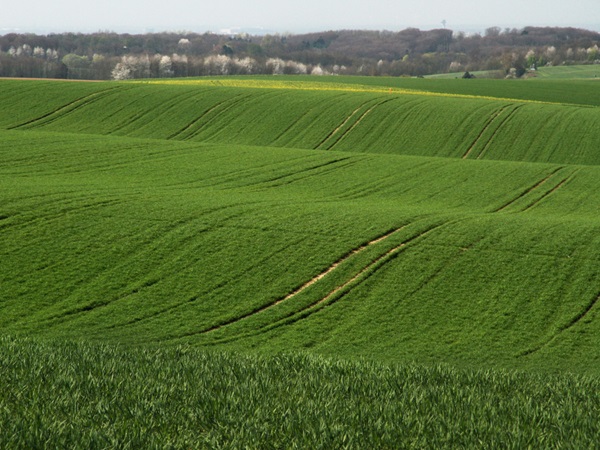 An intensively managed grain field in Germany;
Credit: Guy Pe’er/LIST
An intensively managed grain field in Germany;
Credit: Guy Pe’er/LIST
The Luxembourg Institute of Science and Technology (LIST) recently published a report based on recent research, according to which climate change could become the main driver of biodiversity by the middle of the century and stressing that current policies are insufficient to safeguard biodiversity considering international biodiversity goals.
According to the large multi-model study published in Science on Friday 26 April 2024, global biodiversity may have declined between 2% and 11% during the 20th century due to human-induced land-use change alone. Projections showed that climate change could become the main driver of biodiversity decline by the mid-21st century, LIST emphasised.
Led by the German Centre for Integrative Biodiversity Research (iDiv) and the Martin Luther University Halle-Wittenberg (MLU), this analysis is the largest biodiversity and ecosystem services modelling study of its kind to date. Researchers compared no less than thirteen models for assessing the impact of both land-use change and climate change on four distinct biodiversity metrics, as well as on nine ecosystem services.
Nicolas Titeux, head of LIST’s Observatory for Climate, Environment and Biodiversity, played an active part in this pioneering research, which calls for renewed policy efforts to meet international biodiversity goals. He shared his knowledge of the relative roles of direct drivers of biodiversity change and the way they are integrated into large-scale models. He also ensured that the outcomes of this international collaboration were reflected in the Global Assessment Report of the Intergovernmental Platform on Biodiversity and Ecosystem Services (IPBES).
Global biodiversity may have declined by 2% to 11% due to land-use change alone
Land-use change, or man-made alterations to land and its associated ecosystems, is considered the largest driver of biodiversity change, according to the IPBES. However, scientists are divided on the extent to which biodiversity has changed in recent decades. To better answer this question, the researchers modelled the impacts of land-use change on biodiversity throughout the 20th century.
Based on historical reconstructions, they found that global biodiversity may have declined by 2% to 11% due to land-use change alone. This span covers four biodiversity metrics calculated by seven different models. More precisely, the scientists considered the global and local species richness (i.e. the number of species according to a defined scale), the mean species habitat extent and the biodiversity intactness (i.e. how much of an ecosystem's natural biodiversity remains despite human impacts), LIST added.
Researchers used five different models to see how changes in how we use land affect the services nature provides humans, such as food and timber. They found that in the last century, we harvested a lot more from nature, but at the cost of the destabilisation of pollination, nitrogen retention and keeping carbon in check, which declined “moderately”.
The researchers also examined how biodiversity and ecosystem services might evolve in the future. For these projections, they added climate change to their estimations as a growing driver of biodiversity change.
Climate change stands to put additional strain on biodiversity and ecosystem services, according to the findings. While land-use change remains relevant, climate change could become the most important driver of biodiversity loss by the middle of the century.
“Of course, these comparisons between drivers need to be interpreted with caution,” said co-author Nicolas Titeux. “There are differences in how models capture the impacts of climate and land-use change and in the spatial grain at which these impacts are estimated. This is part of the remaining modelling uncertainties identified by the study.”
The researchers looked at three different scenarios, from sustainable development to a high emissions scenario. In all cases, land-use change and climate change together caused a loss of biodiversity everywhere in the world. While the overall downward trend was consistent, there are considerable variations across global regions, models and scenarios, with the largest declines being projected in South America, Africa and South Asia.
“The purpose of long-term scenarios is not to predict what will happen,” said co-author Inês Martins from the University of York. “Rather, it is to understand alternatives, and therefore avoid these trajectories, which might be least desirable, and select those that have positive outcomes. Trajectories depend on the policies we choose, and these decisions are made day by day.” Martins co-led the model analyses and is an alumna of iDiv and MLU.
The authors also noted that even the most sustainable scenario assessed did not deploy all the policies that could be put in place to protect biodiversity in the coming decades. For instance, bioenergy deployment, one key component of the sustainability scenario, can contribute to mitigating climate change, as well as simultaneously reducing species habitats. In contrast, measures to increase the effectiveness and coverage of protected areas or large-scale rewilding were not explored in any of the scenarios. “This calls for a new generation of scenarios and models that aim to achieve realistic positive futures for biodiversity,” added Nicolas Titeux.
Studying the effects of specific policies on biodiversity helps find out which ones work best to protect and support biodiversity and the services nature provides, according to the researchers. “Our findings clearly show that current policies are insufficient to meet international biodiversity goals. We need renewed efforts to make progress with one of the world’s largest problems, which is human-caused biodiversity change,” concluded the authors.








